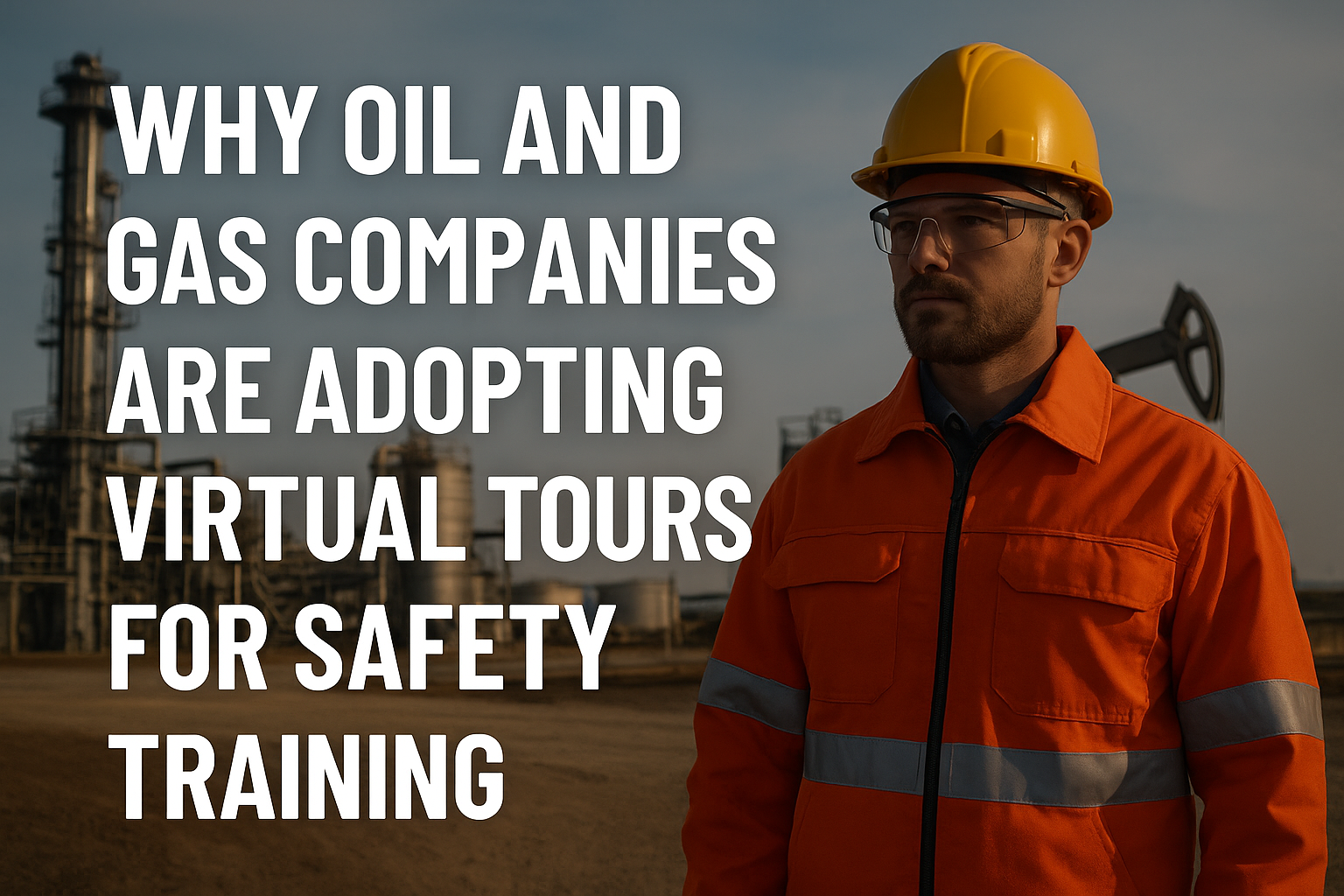🛢️ Why Oil and Gas Companies Are Adopting Virtual Tours for Safety Training
In the high-risk, high-stakes world of oil and gas, safety is the ultimate priority. ⚠️ Yet, many companies still rely on outdated, inefficient training methods that fall short in preparing workers for hazardous environments like offshore platforms, refineries, and drilling sites.
Enter virtual tours — immersive, 360° safety training solutions that are rapidly becoming the new standard across the industry. 🧠💻
In this article, we’ll break down why virtual tours are being adopted at scale, the specific benefits for oil and gas training, and how any company can start using them to protect their workforce and bottom line.
💡 The Problem With Traditional Safety Training
Before we dive into the benefits, it’s important to understand the limitations of conventional training approaches in oil and gas:
- Outdated Materials: Paper manuals and static videos don’t reflect real-time site changes.
- Limited Site Access: New hires often can’t access hazardous or restricted zones for training.
- Low Engagement: Passive learning results in low retention and poor preparedness.
- High Costs: Flying teams to remote sites for in-person training racks up costs in travel, logistics, and downtime.
For an industry where a single mistake can cost millions — or worse, human lives — this simply doesn’t cut it anymore.
🎥 What Is a Virtual Tour for Safety Training?
A virtual safety tour is a realistic, immersive walkthrough of a real-world job site — created with 360° images or video and enhanced with interactive content. Workers can:
- “Walk through” rigs, refineries, and pipelines 🛠️
- Interact with hazard icons and equipment ✅
- Watch safety videos embedded on key scenes 📺
- Complete quizzes and checklists 📝
- Train from a laptop, mobile phone, or VR headset 📱🖥️
Platforms like CloudPano make it easy to build and deploy these safety experiences — no coding or VR background required.
🚀 7 Reasons Oil and Gas Companies Are Adopting Virtual Tours
Let’s explore the specific reasons this technology is gaining serious traction in the energy sector:
1. 🔒 Train Workers Before They Step On Site
Workers can explore complex and hazardous environments before physically arriving, drastically reducing the chance of first-day errors.
They learn:
- Layouts of confined spaces
- Emergency exit locations
- Dangerous zones (e.g., H2S areas)
- Equipment procedures and PPE requirements
This boosts confidence, preparedness, and safety compliance from day one.
2. 🌍 Train Teams Anywhere, Anytime
From remote contractors to international crews, virtual tours allow global training consistency.
No more:
- Expensive site visits
- Scheduling conflicts
- Safety risks for trainees
Trainees simply click a link and begin training — anytime, from anywhere.
3. 🎓 Improve Learning Retention Through Immersion
Immersive training methods (like 360° virtual tours) are proven to boost retention up to 75% compared to traditional classroom lectures.
By simulating real-world conditions, workers develop muscle memory, hazard awareness, and spatial understanding faster.
4. ⏱️ Accelerate Onboarding and Deployment
Virtual safety tours help new hires get up to speed in hours instead of weeks.
This saves supervisors time, reduces hand-holding, and lets employees:
- Arrive job-ready
- Pass safety audits
- Begin productive work immediately
5. 💸 Reduce Training Costs and Liabilities
After the initial setup, virtual tours scale infinitely — with zero cost per additional trainee.
Companies cut costs on:
- Travel and accommodation
- Repeated instructor sessions
- Insurance premiums from preventable incidents
Avoiding one serious accident can save $50,000 to $1M+ in liability and downtime.
6. 📊 Track and Document Safety Training
Modern virtual tour platforms include dashboards that track:
- Tour completion
- Quiz results
- Time spent on each scene
- User activity and engagement
This helps EHS teams prove compliance, generate reports for audits, and identify knowledge gaps.
7. 🔧 Update Instantly for Changing Conditions
Need to reflect a layout change or new safety procedure? Simply swap in new scenes or update instructions inside the virtual tour.
This flexibility is ideal for:
- Rapid response to changing site conditions
- Updating emergency protocols
- Rolling out new regulations across the company
🛠️ Real-World Applications in Oil & Gas
Here’s how different sectors are putting virtual tours into action:
🛢️ Offshore Rig Training
Trainees explore:
- Helicopter landing protocols
- Emergency evacuation drills
- Fire suppression equipment locations
🏭 Refinery Orientation
Workers virtually navigate:
- PPE check-in stations
- Chemical handling areas
- Lock-out/tag-out zones
🔬 Pipeline and Inspection Training
Teams learn:
- Leak detection protocols
- Right-of-way safety
- Isolation valve operation
🚒 Emergency Response Simulation
Train teams to respond to:
- Fires
- Gas leaks
- Blowouts and mass evacuations
All in a virtual, consequence-free environment.
🧩 How to Get Started With Virtual Safety Tours
Step 1: Capture 360° Media
Use a 360° camera to photograph or film key training zones (e.g., job site entry, high-risk areas, emergency exits).
Step 2: Build Your Tour
Upload scenes to a platform like CloudPano. Add interactivity, labels, quizzes, and safety instructions.
Step 3: Share the Tour
Send training links to employees via email, LMS, or your company intranet.
Step 4: Track and Optimize
Use analytics to monitor engagement and make improvements over time.
🧠 Objection Busters
“Our workforce isn’t tech-savvy.”
Virtual tours are intuitive and accessible on phones, tablets, or desktops — no VR headset required.
“This sounds expensive.”
A 360° camera and virtual tour platform cost less than one in-person site visit — and can be reused thousands of times.
“We already have training videos.”
Great! Embed them into the virtual tour for a multimedia, interactive experience.
📈 Final Thoughts: Virtual Tours Are the Future of Safety
In an industry built on precision, discipline, and risk mitigation, virtual safety tours give oil and gas companies a competitive edge.
They don’t just improve training — they prevent accidents, reduce costs, and save lives.
If you’re serious about safety (and you should be), now’s the time to explore what 360° technology can do for your workforce.














.png)



.png)





.png)

.png)





